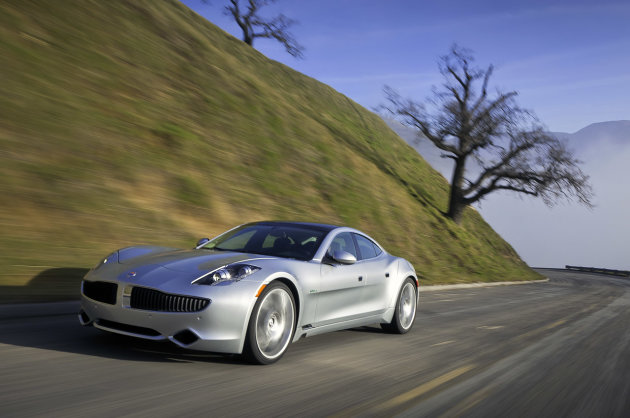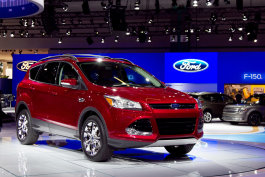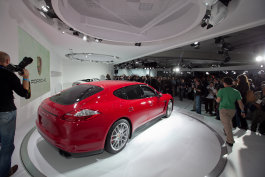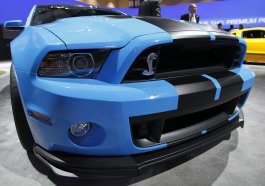Green cars rolled into the spotlight at the
Tokyo auto show as Japan's automakers look to fuel efficient technology to reinvigorate growth after tough times.
The showcase for Japan's pillar auto industry was holding its preview for media on Wednesday ahead of opening to the public on Saturday.
Plug-in hybrids and electric cars are centerstage at the Tokyo Motor Show — reflecting both how green cars are growing in popularity and the low profile of foreign automakers at the event.
The show been scaling back in recent years because of the waning importance of
Japan as an auto market. Car makers — including Japan's — are increasingly looking to
China,
India and other nations with greater growth potential.
Ford Motor Co. of the U.S. skipped the show, and General Motors Co. had only a tiny corner booth. Just a handful of European makers such as BMW with a chance at wooing rich Japanese buyers had full-scale booths.
Japanese automakers have had a tough few years due to the strong yen, image problems from Toyota's massive recalls and the large production disruptions from the March disasters in northeastern Japan. But green technology remains a strong selling point for car makers such as
Toyota Motor Corp. which pioneered broad consumer acceptance of gasoline-electric hybrid cars with its hit Prius.
Honda Motor Co. said it will start selling an electric version of its Fit subcompact in the U.S. and Japan by the middle of next year. It showed concept cars such as the AC-X plug-in hybrid, EV-STER electric roadster convertible and a tiny electric car called Micro Commuter
"We will continue to offer products with an edge," said Honda President Takanobu Ito before drinking orange juice poured by Honda's Asimo robot, which recently has gained more nimble human-like fingers.
Honda showed a portable battery that people could carry around and put not only in their electric cars and plug-ins but also in small electric scooters.
Nissan Motor Co. had an updated version of its futuristic-looking electric car called Pivo 3, which can drive itself, find parking spaces and swerve around in almost a complete circle.
Koichiro Imoto, who writes about Japan's auto industry, says overseas interest in the show has plunged, except for a handful of manufacturers like Volkswagen AG that do good business in Japan.
"Technology is the only thing Japan has to cling to so the show is trying to highlight those strengths," he said. "Selling the technological superiority is the only way left for Japan."
Toyota President Akio Toyoda was outright emotional at his presentation when he said Japan was going through hard times after the March 11 earthquake and tsunami in northeastern Japan.
Japanese automakers, including Toyota Motor Corp., were forced to scale back production as parts suppliers in northeastern Japan were damaged.
That battering was followed by a smaller but similar problem when suppliers got hit by flooding in
Thailand, Toyoda said.
"Japan has been plunged into sadness," he said, often gesturing with his hands to emphasize his points.
Toyota must do all it can to work with the people of northeastern Japan and Thailand to propel a recovery, he said.
"Our messages are 'Fun to drive again,' and 'Never give up,' " he said, using English phrases for the mottos.
Mamoru Katou, auto analyst with Tokai Tokyo Research, believes the most interesting models at the show are the ones close to being commercial models.
On display at Toyota's sprawling booth is the plug-in version of its hit Prius hybrid, which will start at 2.75 million yen ($35,200) with subsidies in Japan.
Toyota began taking orders in Japan for the plug-in on Tuesday. In the U.S., where Toyota has already started to take orders online, the car starts at $32,000 without subsidies, which will vary by state.
Toyota, which has sold more than 3.4 million hybrids worldwide so far, is targeting Prius plug-in sales of 60,000 a year globally. The car is set for delivery in Japan in January.
Toyota is also showing an electric car and a fuel cell prototype.
"Overall, interest is going to be diminished because the economy isn't doing so well around the world," Katou said. "But there's still interest in Toyota cars."
Carlos Ghosn, chief executive at Nissan — which has been aggressive on electric vehicles with its Leaf car, but has been a straggler with hybrids compared to Toyota and Honda — said no single green technology was going to dominate.
In about a decade, electric vehicles will make up 10 percent of the auto market as concerns grow about global warming, and governments in the U.S., Japan, Europe and China encourage their sales, he said.
"Zero-emission cars are going to become more and more popular," Ghosn said on the sidelines of the show. "You need to prepare the technologies."
Suzuki Q-Concept
Part car, part motorcycle and all circles, the Q-Concept is a tandem two-seat electric vehicle that's perfect for trips of less than 6 miles, according to Suzuki. You can even replace the single rear seat with a pair of child seats and turn it into the world's coolest baby stroller
.
Toyota Boshoku T-Brain
Toyota Boshuku is a subsidiary of Toyota that specializes in automobile interiors. Apparently pinstripes will be in around 2020
.
Daihatsu FC SHO CASE
Although it looks like a rolling digital billboard, which it sort of is, the FC SHO CASE features an innovative liquid fuel cell powerplant that uses no precious metals, potentially driving down the cost of this zero emissions technology
.
Daihatsu Pico
Less of a rolling billboard, and more of a hazard sign on wheels, the doorless, 880 pound two-seat Pico electric commuter can display information on its exterior to tell pedestrians and other vehicles exactly which way its going and how fast. With just a bar for side impact protect, avoiding contact with anything seems like a good idea
.
Nissan PIVO3
The PIVO3 concept comes with its own valet (not the guy standing next to it, that's Nissan CEO Carlos Gohsn.) The electric car features a system called Automated Valet Parking which would allow a driver to get out of the car and let it seek out a vacant spot on its own, preferably one with an inductive charging pad to refill its batteries.
And it shouldn't have too much trouble finding one. The three-seat vehicle is less than 10 feet long and has four-wheel steering, allowing it to drive practically sideways and make a U-turn in the tightest spaces.
Source: Foxnews

























